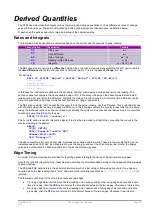
UM-0085-B09
DT80 Range User Manual
Page 88
RG
•
priority
is
normal
(default) or
low
. A normal priority message will be sent as soon as possible. Low priority
messages are queued and will be sent at the start of the next communications session. Unlike email, if a
session is already active then low priority SMS will still be deferred until the start of the next session (see
below).
•
body
is a string to use as the body of the text message. If not specified then the alarm action text is used.
Note1:
sending an SMS in the middle of an active session may cause the established data connection to be disrupted and the session
to end prematurely. For this reason, SMS messages are normally sent at the start of the session, and low priority SMS messages that
occur during a session are deferred until the start of the next session.
Note2:
No more than 5 SMS messages can be queued; any subsequent attempts will be discarded (a message will be written to the
event log, and a warning SMS will be generated).
See
Communications Sessions (P222)
for more details about how SMS transmission is managed.
Examples
Send the alarm text to an email address and two phone numbers:
IF(1CV<10)"LowPress:
?v"[sms:+61400123456][sms:+12125550909][mailto:[email protected]]
Note:
unlike email, sending to multiple SMS recipients involves multiple operations, each of which will be charged at the applicable SMS
rate.
Send a test SMS:
DO[sms:+61400123456?body=Test only!]
Limits
Be aware of the following command length limits when crafting complex alarm commands. These limits apply to the
resultant string after substituting any replaceable parameters:
Element
Max number of characters
Complete command line
1023
Email recipient(s)
255
Option list: priority, subject, body
511
Email subject
255
Email message body
255
SMS phone number
19
SMS message body
160
Note:
if any special characters (e.g.
@
,
:
) appear within a component of an email or SMS URI then they should be replaced with the
appropriate "escape sequence", to prevent them being confused with the characters used to separate the various URI components.
See
for more details.
Alarm Action Processes
Action processes
can be any DT80 functions to be executed when an alarm is true. These functions can be reading
input channels, setting output channels, calculations, setting parameters and switches, and so on.
In addition, action processes are a very powerful programming facility for the DT80. Use them to perform a wide range of
program-related functions such as re-programming on events, adaptive schedules (see examples below), programmed
calibration cycles, management of digital state outputs, and management of the Serial Channel.
Action processes are also useful with unconditional alarm commands (
DO
commands) as a means of executing a DT80
command (as opposed to a channel) within a schedule. See
Executing Commands in Schedules (P59)
for more details.
Action processes are placed within braces { } as the last element in an alarm command. Each "process" is either:
•
a channel definition (e.g.
1+V(=1CV)
or
3DSO=0
), or
•
a command (e.g.
XC
or
P12=5
or
SATTN
or
LOGONA
), or
•
a schedule trigger re-definition (e.g.
RA100T
)
Alarm commands cannot be included.
Any number of processes may be included, but they must all be on the same line. Processes can be separated by semi-
colon (
;
) or space characters.
Содержание DT80
Страница 29: ...UM 0085 B09 DT80 Range User Manual Page 29 RG The DT80 File System P114 ...
Страница 184: ...UM 0085 B09 DT80 Range User Manual Page 184 RG Figure 71 DT80 communications options ...
Страница 185: ...UM 0085 B09 DT80 Range User Manual Page 185 RG Figure 72 DT80 communications options integrated modem models ...
















































